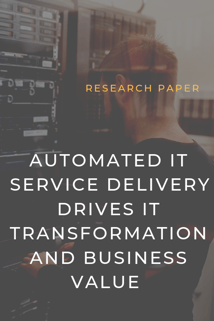In Today's increasingly competitive market, technology plays an important role in giving a business the ability to innovate. At the center of this, IT must evolve from an enabler of back-office processes into an organization that drives innovation and growth. With so many trends disrupting the way businesses operate the common topic of discussion is now around transformation. But exactly what is IT Transformation and what impact does it have in business agility?
IT Transformation Defined
IT transformation is defined as the act of modernizing and automating information technology systems and processes to optimize the business ability to take faster and cost-effective decisions. It is a major task but it has well-known benefits that make the effort well worth it.
In this digital world, where technology is at the center of every business aspect, transformation, change and innovation cannot happen unless IT its transformed as well. This process means being able to evolve from a less flexible organization into a more proactive and agile team, that's able to respond quickly to critical business demands. That's the power of IT Transformation.
Digital Transformation vs. IT Transformation
Another industry term that has been around is digital transformation. Although many consider it to be the same they are in fact different.
- Digital Transformation focuses on the ability and mindset an organization has to embrace change, becoming the disruptor, not the disrupted. How is a business considering digital technologies within their growth strategies, the power of making data-driven decisions to out-innovate, out-think, and outpace competitors.
- IT transformation centers on modernizing the core underlying technologies that enable efficiency, speed, scale, and cost-effectiveness. It considers ways to streamline processes using cutting-edge technologies to automate and fuel digital transformation initiatives. Data Center virtualization, Hyperconverged Infrastructures and Multi Cloud projects are all considered to be enablers of IT transformation.
Key drivers for IT Transformation strategy
Transformation is essential for companies that want to stay ahead of competitors. But what are the core elements one must consider when assessing the stage of your IT transformation?
Commissioned by DellEMC, Enterprise Strategy Group (ESG) did research of more than 4,000 IT leaders, finding that most of them agreed on three key elements as reasons why IT transformation is essential for their business:
- The dependency they see between IT and digital transformation. Ninety-six percent of respondents agreed to prioritize digital transformation initiatives, and those initiatives are linked to IT transformation progress. Those organizations that have their IT Transformation plans in a mature stage were 19 times more likely to have ongoing digital transformation projects.
- Time-to-market pressures. Eighty-eight percent of respondents said it's important to have a more agile approach to IT as a way to speed up time-to-market for products and services. Agility and ability to scale digitally is a key reason to transform their IT infrastructure.
- A pervasive requirement to reduce costs. Success depends on having a reliable, highly automated, easy-to-deploy, and easy-to-manage infrastructure. Even Transformed IT organizations get measured on keeping costs low and delivering projects on/under budget.
Reaping the benefits of IT Transformation
To deepen the reasons why IT transformation is important, consider the following benefits shown by transformed organizations with a high maturity level. Companies leveraging IT as a Service:
- Completed 13% more projects ahead of schedule.
- Were nearly 15X more likely to report completing application deployments ahead of schedule
- Were 5.5X more likely to be ahead of their competition in time to market
- Were 2.5X more likely to operate an on-site infrastructure that is cost-effective (or more so) than the public cloud.
- Were 5X more likely to exceed their revenue goals by more than 10%.
This shows a direct, and more important measurable relation between transformed infrastructure and business agility, greater spending efficiency, faster time to market, and funding reallocation towards innovation.
Why is IT Transformation more important than ever?
Simple, things are changing too quickly. The fast-pace of technology innovations and digital disruptions leave little to no time for organizations to react. That's why thinking strategically about growth and putting innovation at the center, will show you a clear path where IT transformation is necessary to thrive.
Regardless of your company size, your business needs to evolve an address the changing business landscape. You want your IT to be a focus on business results, innovation, and continuous improvement. You will then see as your IT organization progress in transforming itself, it will then be measured based on how they enable and support revenue-generation projects, budget optimization becomes a second performance metric.
The bottom line is, transforming your infrastructure is a critical step into becoming a digital organization with the ability to out-innovate, out-perform, and outpace competitors. Although it might seem like a tedious path, it has proven to have a direct correlation with greater business outcomes, increasing business agility, cost efficiency, and greater competitiveness.
 Automated IT Service Delivery Drives IT Transformation and Business Value
Automated IT Service Delivery Drives IT Transformation and Business Value
The Quantified Impacts of Using a Cloud Operating Model.
A company that transforms its IT infrastructure no longer has to rely in rigid, manual, siloed, legacy technologies. It sees a boost in IT operational speed, efficiency, costs, and scale. Those IT-level improvements fuel a larger-scale digital transformation, allowing the company to thrive in today's digital economy. Read this Industry Report and learn more benefits businesses are seeing after embarking on an IT transformation project.





